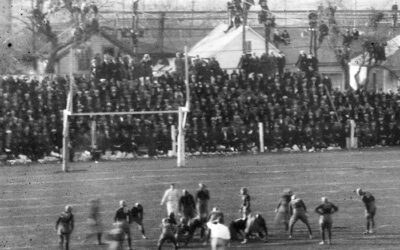Imagine being responsible for a museum collection and coming across an artifact that appears to be melting before your eyes! That is exactly what happened at the Ford Conservation Center recently. Last year, we had received a group of objects from the Harry S. Truman Library. The library staff wanted us to write proposals for treatment ahead of an exhibit on President Truman’s experience during World War I. One of the objects was a seemingly ordinary celluloid protractor. When it came to us, it was clear and intact. Although it was beginning to show signs of degradation, such as yellowing, it appeared to be stable.
This is what the protractor looked like when it arrived at the Ford Center.
It’s Melting!
While awaiting treatment, the protractor had been kept within the open Mylar sleeve in which it had arrived. It had been housed within an archival box, and kept in the dark in stable environmental conditions. When the protractor was taken out a year later to create a new housing for it as we had recommended, advanced symptoms of degradation were visible.
There were pools of pungent, acidic liquid on the surface and the protractor was more discolored than what it had been. New cracking from the celluloid contracting was noted at the corners. When it was taken out of its sleeve, and transferred to another surface, it immediately began curling up and cracking further.
The protractor was placed between two sheets of perforated Mylar clamped to a board to help restrain it as it continues to degrade. The perforated Mylar covering was peeled back each day for a week in order to remove acidic deterioration products from the surface. This was done by blotting the surface with MicroChamber® paper or tissue paper in areas where no text was present.
The liquid on the surface was tested with pH strips and was shown to be extremely acidic, with a pH of less than 1, which is close to battery acid! In order to treat this object, conservators had to wear goggles and use ventilation so as not to get acid burns from the fumes.
Acidic liquid on the surface of the protractor.
Inherent Vice
In the course of a year (not a long time when you consider this object is over 100 years old) the protractor appeared to be melting! This type of degradation is called “inherent vice.” Inherent vice refers to degradation that occurs “because of the incompatibility of different materials or because of poor quality or unstable materials.”[1] Many modern materials, such as some plastics, are unstable over long-periods of time.
While Mylar is chemically inert, cellulose nitrate is inherently unstable and slowly decomposes at room temperature.[2] Unfortunately, there is not much that can be done to stop it.
We are currently creating a housing, or safe and supportive storage box that will restrain the object while at the same time allowing degradation products to off-gas or be absorbed into changeable MicroChamber® papers or board. The best option would be for the library to store it in cold storage to slow down the chemical processes of degradation. If that isn’t possible, the next best thing will be to keep the protractor in its new housing, in a well-ventilated area where degradation gases won’t harm other objects. It is also important to keep it separated from other objects as cellulose nitrate, which is used in celluloid, is flammable. It is advised that library staff check on the protractor at least annually to note its condition, and replace the pollutant-absorbing paper that will be included in the housing.
Restraining the protractor with clamps and MicroChamber® paper to adsorb degradation products.
[1] Johnson, J. (1999). Part I, Chapter 4: Museum collections environment. In National Parks Service Museum Handbook (p. 4:7). Washington, DC: National Parks Service. Retrieved from http://www.nps.gov/museum/publications/MHI/CHAPTER4.pdf
[2] Conservation and Art Materials Encyclopedia Online (CAMEO), http://cameo.mfa.org/wiki/Cellulose_nitrate, https://cameo.mfa.org/wiki/Mylar



